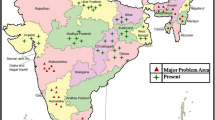Abstract
Besides being a pathogen, powdery scab (Spongospora subterranea (Wallr.) Lagerh. f. sp. subterranea) is also a vector of potato mop-top virus (PMTV). Powdery scab is very widely distributed but PMTV has a more narrow distribution. It is confined to areas with a cool and humid climate and is found in Northern Europe, Northern America, China, Japan and the Andes region. Powdery scab attacks many different plant species but only species in the Solanaceae and Chenopodiaceae are hosts of PMTV. The symptoms of PMTV infection include spraing (brown-coloured arcs or spots) in the tubers, yellow blotching or chlorotic V-shapes in the leaves and stunting of the stems. The infection is partially systemic and is self-eliminating after a few generations when the tubers are planted in clean soil. The main source of inoculum is therefore viruliferous sporeballs of powdery scab. The virus is situated inside the spores and is transmitted by the zoospores during fungal attack. Isolates of powdery scab free of PMTV will become viruliferous by attacking PMTV-infected plants. The sporeballs of powdery scab are very long lived and PMTV infection has been obtained from 18-year-old sporeballs. PMTV can be artificially transmitted by sap. Isolates kept in the laboratory by sap transmission in many generations tend to loose the vector transmissibility by a deletion in the CP-encoding RNA subunit.
Resumen
Además de ser un patógeno, (Spongospora subterránea (Wallr.) Lagerth f. sp. subterránea) la roña es también un vector del virus del mop top (PMTV). La roña está ampliamente distribuida pero el PMTV tiene distribución más limitada. Está confinada a áreas con clima frío y húmedo y se encuentra en el Norte de Europa, Norte América, China, Japón y la región de los Andes. La roña ataca muchas plantas de especies diferentes pero solamente especies entre las Solanáceas y las Chenopodiaceas son hospederos del PMTV. Los síntomas de la infección con PMTV incluyen erupciones en el tubérculo (arcos de color marrón o manchas), manchas de color amarillo o manchas cloróticas en forma de V en las hojas y enanismo de los tallos. La infección es parcialmente sistémica y se auto elimina después de unas cuantas generaciones, cuando el tubérculo se siembra en suelo limpio. La principal fuente de inóculo son por lo tanto las masas de esporas de la roña. El virus se encuentra dentro de las esporas y es trasmitido por las zoosporas durante el ataque del hongo. Aislamientos de roña libres del PMTV se vuelven virulíferos al atacar a plantas infectadas con PMTV. Las masas de esporas de la roña viven mucho tiempo y se ha obtenido infección de masas de esporas de 18 años. El PMTV puede ser transmitido artificialmente por medio de savia infectada. Los aislamientos guardados en el laboratorio por transmisión de savia en muchas generaciones tienden a perder su trasmisibilidad como vector debido a una deleccion en la subunidad de ARN que codifica el CP.


Similar content being viewed by others
References
Andersen, B.A.B., M. Nicolaisen, and S.L. Nielsen. 2002. Alternative hosts for potato mop-top virus, genus Pomovirus and its vector Spongospora subterranea f. sp. subterranea. Potato Research 45: 37–43.
Arif, M., L. Torrance, and B. Reavy. 1995. Acquisition and transmission of potato mop-top furovirus by a culture of Spongospora subterranea f, sp, subterranea derived from a single cystosorus. Annals of Applied Biology 126: 493–503.
Calvert, E.L. 1968. The reaction of potato varieties to potato mop-top virus. Record of Agricultural Research - Ministry of Agriculture for North Ireland 17: 31–40.
Cooper, J.I., and B.D. Harrison. 1973. Distribution of potato mop-top virus in Scotland in relation to soil and climate. Plant Pathology 22: 73–78.
Jones, R.A.C. 1988. Epidemiology and control of potato mop-top virus. Pages 255–279 in: Proceedings of a conference on viruses with fungal vectors at the University of St Andrews.
Jones, R.A.C., and B.D. Harrison. 1969. The behaviour of potato mop-top virus in soil, and evidence for its transmission by Spongospora subterranea (Wallr.) Lagerh. Annals of Applied Biology 63: 1–17.
Jones, R.A.C., and B.D. Harrison. 1972. Ecological studies on potato mop-top virus in Scotland. Annals of Applied Biology 71: 47–57.
Lambert, D.H., L. Levy, V.A. Mavrodieva, S.B. Johnson, M.J. Babcock, and M.E. Vayda. 2003. First report of potato mop-top virus on potato from the United States. Plant Disease 87: 872.
Mølgaard, J.P., and S.L. Nielsen. 1996. Influence of post harvest temperature treatment, storage period and harvest date on development of spraing caused by tobacco rattle virus and potato mop-top virus. Potato Research 39: 571–579.
Nielsen, S.L., and J.P. Mølgaard. 1997. Incidence, appearance and development of potato mop-top furovirus-induced spraing in potato cultivars and the influence on yield, distribution in Denmark and detection of the virus in tubers by ELISA. Potato Research 40: 101–110.
Nielsen, S.L., and M. Nicolaisen. 2003. Identification of two nucleotide sequence subgroups within potato mop-top virus. Archives of Virology 148: 381–388.
Plant diseases, pests and weeds in Denmark: annual report 1986 compiled by The Research Centre for Plant Protection 103: 39–41.
Sandgren, M. 1995. Potato mop-top virus (PMTV): distribution in Sweden, development of symptoms during storage and cultivar trials in field and glasshouse. Potato Research 38: 379–389.
Sandgren, M., E.I. Savenkov, and J.P.T. Valkonen. 2001. The readthrough region of potato mop-top virus (PMTV) coat protein encoding RNA, the second largest RNA of PMTV genome, undergoes structural changes in naturally infected and experimentally inoculated plants. Archives of Virology 146: 467–477.
Sokmen, M.A., H. Barker, and L. Torrance. 1998. Factors affecting the detection of potato mop-top virus in potato tubers and improvement of test procedures for more reliable assays. Annals of Applied Biology 133: 55–63.
Torrance, L., G.H. Cowan, M.A. Sokmen, and B. Reavy. 1999. A naturally deleted form of RNA2 of potato mop-top virus. Journal of General Virology 80: 2211–2215.
Author information
Authors and Affiliations
Corresponding author
Rights and permissions
About this article
Cite this article
Kirk, H.G. Mop-top Virus, Relationship to Its Vector. Am. J. Pot Res 85, 261–265 (2008). https://doi.org/10.1007/s12230-008-9021-7
Published:
Issue Date:
DOI: https://doi.org/10.1007/s12230-008-9021-7




